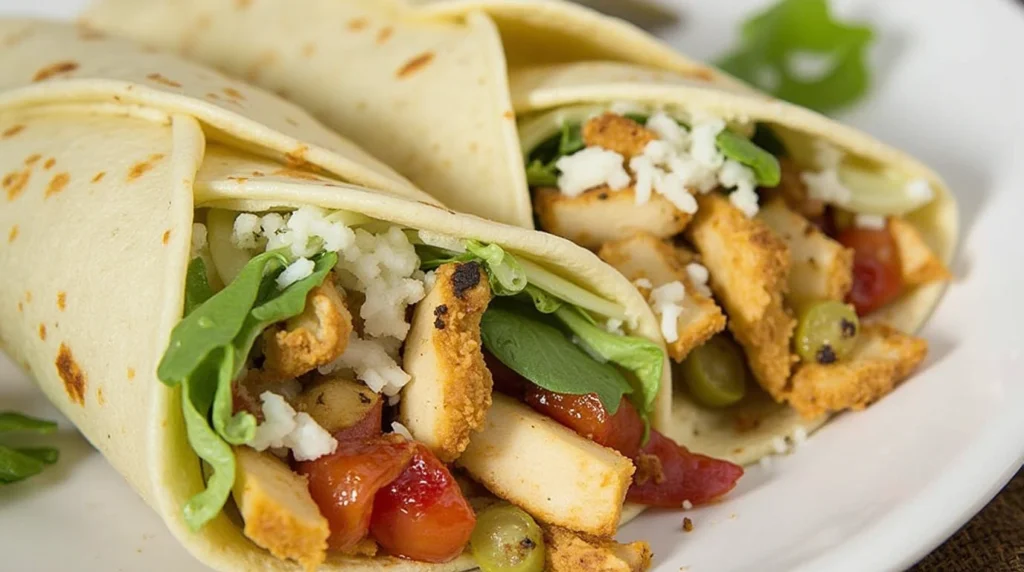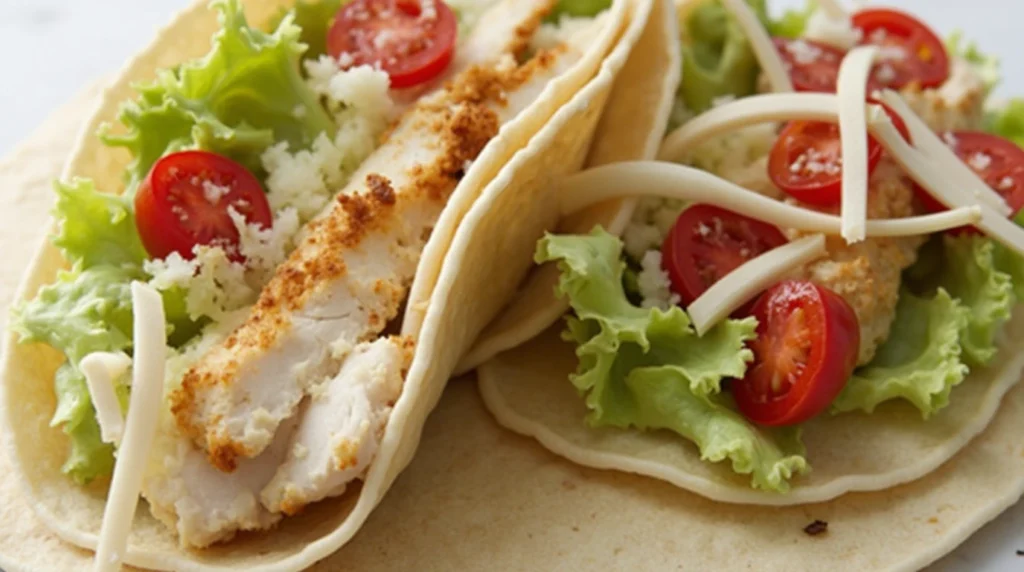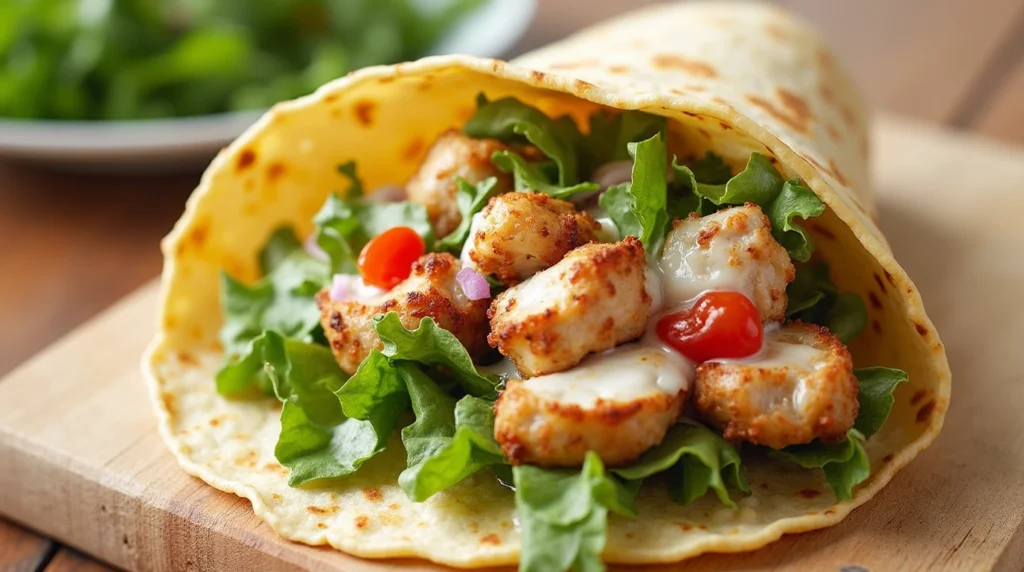We’ve all been there—staring at the menu, trying to choose between something delicious and something healthy. What if you could have both? Enter the Chicken Caesar Wrap, a meal that’s not only satisfying but can also fit seamlessly into a healthy diet. But how many calories are in a Chicken Caesar Wrap? Is it really as healthy as it seems? In this article, we’ll break down everything you need to know about Chicken Caesar Wrap calories, from its nutritional value to tips for making it lighter and healthier. Whether you’re counting calories, meal prepping, or just looking for a tasty lunch option, this guide has you covered.

How Many Calories Are in a Chicken Caesar Wrap?
When it comes to calorie count, a Chicken Caesar Wrap can vary widely depending on how it’s made. Here’s what you need to know:
- Average Calorie Count: A standard Chicken Caesar Wrap typically contains 400-600 calories.
- Factors That Influence Calories:
- Portion Size: Larger wraps with more chicken or dressing will have more calories.
- Ingredients: Croutons, extra cheese, and creamy dressings can add significant calories.
- Dressing Type: Store-bought Caesar dressing often has more calories than homemade versions.
- Homemade vs. Store-Bought:
- Homemade wraps usually have fewer calories because you can control the ingredients.
- Store-bought wraps may contain added preservatives and higher-calorie dressings.
- Tips for Reducing Calories:
- Use light or Greek yogurt-based Caesar dressing.
- Skip croutons or replace them with chopped nuts for a healthier crunch.
- Opt for whole wheat or low-carb tortillas.
Nutritional Breakdown of a Chicken Caesar Wrap
Understanding the nutritional profile of a Chicken Caesar Wrap can help you make informed choices. Here’s a detailed breakdown:
Protein
- Grilled chicken breast is a lean protein source, providing 30-40 grams per wrap.
- Protein helps keep you full and supports muscle repair and growth.
Carbohydrates
- A whole wheat tortilla contains 30-40 grams of carbs, while regular tortillas may have slightly more.
- Whole wheat options are higher in fiber, which aids digestion and keeps you satisfied longer.
Fats
- Healthy fats come from ingredients like olive oil, Parmesan cheese, and Caesar dressing.
- These fats are essential for energy and nutrient absorption.
Vitamins and Minerals
- Romaine lettuce is rich in vitamins A and K, which support eye health and bone strength.
- Other nutrient-rich ingredients include garlic (antioxidants) and lemon juice (vitamin C).

Is a Chicken Caesar Wrap Healthy? Pros and Cons
Like any meal, a Chicken Caesar Wrap has its pros and cons. Let’s weigh them:
Pros
- High in Protein and Fiber: Keeps you full and supports muscle health.
- Nutrient-Dense Ingredients: Romaine lettuce, grilled chicken, and olive oil offer essential vitamins and minerals.
- Customizable: Easily adapted for low-carb, gluten-free, or keto diets.
Cons
- High-Calorie Dressings: Store-bought Caesar dressing can be loaded with calories and sodium.
- Croutons and Cheese: These add-ons can increase calorie count without adding much nutritional value.
Tips for a Healthier Wrap
- Use light or homemade Caesar dressing.
- Skip croutons or replace them with chopped veggies.
- Add avocado for healthy fats and creaminess.
How to Make a Low-Calorie Chicken Caesar Wrap
Want to enjoy a Chicken Caesar Wrap without the guilt? Follow these steps:
Choose Lean Protein
- Use skinless grilled chicken breast for maximum protein with minimal fat.
Opt for Whole Wheat Tortillas
- Whole wheat tortillas are higher in fiber and lower in calories compared to regular tortillas.
Use Light or Homemade Dressing
- Make your own dressing using Greek yogurt, lemon juice, garlic, and a touch of Parmesan.
Add Veggies for Volume
- Load up on romaine lettuce, spinach, or cucumbers for added nutrients and crunch.
Chicken Caesar Wrap vs. Other Wraps: Calorie Comparison
How does a Chicken Caesar Wrap stack up against other popular wraps? Let’s compare:
| Wrap Type | Average Calories | Key Differences |
|---|---|---|
| Chicken Caesar Wrap | 400-600 | Lean protein, fresh veggies, creamy dressing |
| Chicken Salad Wrap | 500-700 | Often higher in calories due to mayo-based dressing |
| Beef or Pork Wrap | 600-800 | Red meat adds more calories and saturated fat |
| Vegetarian Wrap | 300-500 | Lower in calories but may lack protein |
The Role of Portion Control in Managing Chicken Caesar Wrap Calories
Even the healthiest meals can become calorie-dense if portion sizes aren’t managed properly. Here’s how to keep your Chicken Caesar Wrap in check:
Why Portion Control Matters
- Overloading your wrap with extra chicken, cheese, or dressing can double the calorie count.
- Larger portions may lead to overeating, even if the ingredients are healthy.
H3: Tips for Proper Portioning
- Measure Ingredients: Use a kitchen scale or measuring cups to ensure you’re adding the right amounts.
- Stick to One Protein Source: Avoid adding multiple proteins (e.g., chicken and bacon) to keep calories in check.
- Limit High-Calorie Add-Ons: Use croutons, cheese, and dressing sparingly.
- Fill Up on Veggies: Add extra lettuce, spinach, or cucumbers to bulk up your wrap without adding many calories.
H2: How to Meal Prep Chicken Caesar Wraps for a Healthy Week
Meal prepping is a game-changer for staying on track with your diet. Here’s how to prep Chicken Caesar Wraps for the week:
Step-by-Step Meal Prep Guide
- Cook the Chicken: Grill or bake 4-5 chicken breasts at the beginning of the week. Slice them into strips for easy assembly.
- Prep the Veggies: Wash and chop romaine lettuce, cucumbers, and any other veggies you plan to use.
- Make the Dressing: Prepare a batch of light Caesar dressing and store it in a small container.
- Assemble When Ready: To prevent soggy wraps, store ingredients separately and assemble your wrap just before eating.
Storage Tips
- Chicken: Store in an airtight container in the fridge for up to 4 days.
- Veggies: Keep them fresh by storing them in a container with a paper towel to absorb moisture.
- Dressing: Store in a small jar or squeeze bottle for easy portioning.

The Environmental Impact of Your Chicken Caesar Wrap Ingredients
Choosing sustainable ingredients can make your meal even better for the planet. Here’s how:
Sustainable Ingredient Choices
- Chicken: Opt for organic or free-range chicken, which is often raised in more humane and environmentally friendly conditions.
- Lettuce: Buy locally grown romaine lettuce to reduce your carbon footprint.
- Tortillas: Look for brands that use sustainable farming practices for their grains.
- Dressing: Make your own dressing to avoid single-use plastic bottles.
Reducing Food Waste
- Use leftover grilled chicken for salads, soups, or sandwiches.
- Repurpose extra veggies into stir-fries or smoothies.
How to Turn Your Chicken Caesar Wrap into a Salad
If you’re in the mood for something lighter, this recipe can easily be transformed into a salad:
Steps to Make a Chicken Caesar Salad
- Chop the Ingredients: Dice the grilled chicken and romaine lettuce into bite-sized pieces.
- Add Toppings: Include croutons, Parmesan cheese, and any other add-ins you love.
- Toss with Dressing: Drizzle with Caesar dressing and toss until evenly coated.
- Serve: Enjoy as a refreshing, low-carb alternative to the wrap.
Benefits of a Salad Version
- Lower in calories if you skip the tortilla.
- Easier to customize with additional veggies or proteins.
The Perfect Beverage Pairings for Your Chicken Caesar Wrap
What you drink with your wrap can enhance the experience. Here are some ideas:
Refreshing Drink Options
- Iced Tea: A classic choice that complements the flavors without overpowering them.
- Sparkling Water: Add a slice of lemon or lime for a refreshing, fizzy drink.
- Smoothie: A green smoothie with spinach, apple, and banana makes for a healthy, balanced meal.
How to Host a Chicken Caesar Wrap Party
Turn this recipe into a fun, interactive meal with friends or family:
Setting Up a Wrap Bar
- Lay Out Ingredients: Place grilled chicken, veggies, dressings, and tortillas in separate bowls.
- Offer Variety: Include different proteins (like shrimp or tofu), veggies, and dressings.
- Provide Instructions: Share the step-by-step guide so everyone can build their own wrap.
- Add Sides and Drinks: Offer chips, dips, and beverages to round out the meal.
Why It’s a Great Idea
- Encourages creativity and interaction.
- Allows guests to customize their wraps to their preferences.
Final Call-to-Action
Now that you’ve learned everything about Chicken Caesar Wrap calories and how to make this meal healthier, it’s time to put that knowledge into action. Whether you’re cooking for yourself, your family, or a group of friends, this recipe is sure to impress.
The Science Behind Satiety: Why Chicken Caesar Wraps Keep You Full
Understanding why certain meals keep you full longer can help you make smarter food choices. Here’s why a Chicken Caesar Wrap is so satisfying:
Protein’s Role in Satiety
- Grilled chicken is a high-quality protein source, which helps regulate hunger hormones and keeps you feeling full.
- Studies show that protein-rich meals can reduce cravings and prevent overeating.
Fiber’s Impact on Fullness
- Whole wheat tortillas and romaine lettuce are rich in dietary fiber, which slows digestion and promotes satiety.
- Fiber also helps stabilize blood sugar levels, preventing energy crashes.
Healthy Fats for Sustained Energy
- Olive oil and Parmesan cheese provide healthy fats, which are digested slowly and keep you energized for hours.
How to Customize Your Chicken Caesar Wrap for Different Diets
Whether you’re following a specific diet or have dietary restrictions, this wrap can be adapted to suit your needs. Here’s how:
Keto-Friendly Version
- Replace the Tortilla: Use a low-carb wrap or lettuce leaves.
- Skip Croutons: Opt for chopped nuts or seeds for crunch.
- Use Keto-Friendly Dressing: Make your own with olive oil, Parmesan, and garlic.
Gluten-Free Version
- Choose Gluten-Free Tortillas: Look for certified gluten-free options.
- Check Dressing Labels: Ensure your Caesar dressing is gluten-free.
- Avoid Croutons: Replace them with gluten-free crackers or seeds.
Vegetarian Version
- Swap Chicken for Tofu or Chickpeas: These plant-based proteins are just as filling.
- Add Extra Veggies: Include avocado, roasted peppers, or sun-dried tomatoes for flavor.
The Psychology of Food: Why We Love Chicken Caesar Wraps
There’s more to our love for Chicken Caesar Wraps than just taste. Here’s the psychology behind it:
Comfort Food Factor
- The creamy dressing, crunchy lettuce, and savory chicken create a comforting combination.
- Wraps are handheld and easy to eat, making them feel indulgent yet practical.
Visual Appeal
- The vibrant colors of romaine lettuce, golden chicken, and white Parmesan make the wrap visually appealing.
- A well-presented meal can enhance the eating experience.
Nostalgia and Familiarity
- Caesar salads and wraps are classic dishes that many of us grew up with, evoking feelings of nostalgia.

How to Make Your Chicken Caesar Wrap Instagram-Worthy
In the age of social media, presentation matters. Here’s how to make your wrap look as good as it tastes:
Styling Tips
- Use a Colorful Plate: A bright or patterned plate can make your wrap stand out.
- Slice Diagonally: Cutting the wrap in half diagonally creates an attractive presentation.
- Garnish Thoughtfully: Add a sprinkle of Parmesan or a drizzle of dressing on the plate for a professional touch.
H3: Lighting and Angles
- Natural light is your best friend for food photography.
- Shoot from above or at a slight angle to capture all the layers of your wrap.
H2: The Economic Benefits of Making Chicken Caesar Wraps at Home
Eating out can be expensive, but making your own wraps at home can save you money. Here’s how:
H3: Cost Comparison
- Store-Bought Wrap: 8−8−12 per wrap at a café or restaurant.
- Homemade Wrap: 3−3−5 per wrap, depending on ingredients.
Bulk Buying Tips
- Purchase chicken breasts in bulk and freeze them for future use.
- Buy tortillas and dressing in larger quantities to save money.
Reducing Food Waste
- Use leftover ingredients for other meals, like salads or stir-fries.
The Global Appeal of Chicken Caesar Wraps
The Chicken Caesar Wrap isn’t just popular in one region—it’s loved worldwide. Here’s why:
Adaptability to Local Tastes
- In Mexico, wraps might include spicy salsa or avocado.
- In Asia, they might feature sesame dressing or pickled veggies.
Universal Ingredients
- Chicken, lettuce, and cheese are widely available and loved across cultures.
Final Thoughts and Call-to-Action
A Chicken Caesar Wrap is more than just a meal—it’s a versatile, satisfying, and healthy option that fits into almost any lifestyle. By understanding its calorie content, nutritional value, and customization options, you can enjoy this dish guilt-free.
Ready to get started? Gather your ingredients, follow the tips in this guide, and create your perfect Chicken Caesar Wrap. Don’t forget to share your results with us! Tag us on social media or leave a comment below. We can’t wait to see your culinary creations.http://EatingWell’s Healthy Wrap Recipes
Frequently Asked Questions (FAQ)
1. How many calories are in a Chicken Caesar Wrap?
- Typically 400-600 calories, depending on ingredients and portion size.
2. Can I make a Chicken Caesar Wrap keto-friendly?
- Yes! Use a low-carb tortilla and skip croutons.
3. Is a Chicken Caesar Wrap good for weight loss?
- Absolutely, if made with lean protein, light dressing, and whole wheat tortillas.
4. What can I substitute for Caesar dressing to reduce calories?
- Try a Greek yogurt-based dressing or a light vinaigrette.
Conclusion
A Chicken Caesar Wrap can be a delicious and healthy addition to your diet when made with the right ingredients. By understanding its calorie count and nutritional value, you can enjoy this meal without compromising your health goals. Whether you’re meal prepping, looking for a quick lunch, or trying to eat healthier, this wrap is a versatile and satisfying option.
